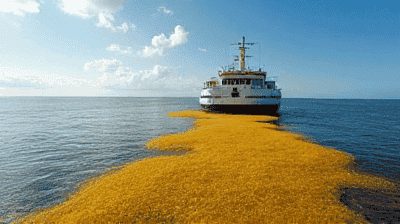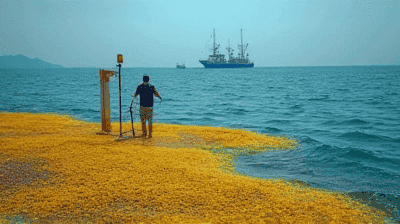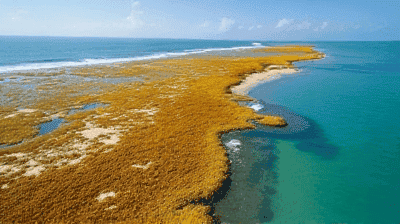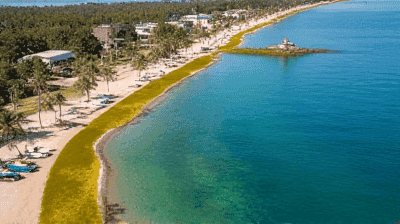
In recent years, the Atlantic Ocean has witnessed a remarkable yet concerning phenomenon: the massive influx of Sargassum, a type of brown seaweed, onto coastlines from the Caribbean to the Gulf of Mexico. This phenomenon, often referred to as the "Great Atlantic Sargassum Invasion," has raised alarm among scientists, environmentalists, and coastal communities alike. While Sargassum plays an essential role in marine ecosystems, its unprecedented growth and accumulation have significant ecological, economic, and health implications.
Sargassum is a genus of brown macroalgae that floats on the ocean's surface. Unlike many types of seaweed, Sargassum is not attached to the seabed but exists as free-floating mats, often providing essential habitat for a variety of marine life.
There are two primary species of Sargassum that are often discussed in the context of the invasion:
Sargassum serves several important ecological functions within marine ecosystems:

The sudden proliferation of Sargassum has been attributed to a combination of factors, both natural and anthropogenic. Understanding these causes is crucial for addressing the invasion's impacts.
Climate change is one of the primary drivers behind the Sargassum invasion. Rising ocean temperatures and increased levels of carbon dioxide in the atmosphere promote the growth of Sargassum and its reproduction. Warmer waters create optimal conditions for algal blooms, leading to larger and more persistent mats.
The increase in nutrient runoff from agricultural and urban areas is another significant factor contributing to Sargassum's rapid growth. Excess nitrogen and phosphorus from fertilizers, sewage, and industrial discharges enter coastal waters, creating nutrient-rich environments conducive to algal blooms. This phenomenon, known as eutrophication, leads to the overgrowth of Sargassum.
Shifts in ocean currents and wind patterns, which can be influenced by climate change, have played a role in the distribution and accumulation of Sargassum. Changes in these patterns can facilitate the movement of Sargassum from its natural habitat in the Sargasso Sea to coastal regions where it can cause problems.
Overfishing and habitat degradation, particularly of coastal ecosystems like reefs and mangroves, can disrupt the balance of marine ecosystems. These factors may create conditions that favor the unchecked growth of Sargassum, reducing competition from other marine species.
The recent invasion of Sargassum has affected a wide range of coastal areas, including:
The Sargassum invasion has far-reaching impacts on marine ecosystems, coastal communities, and economic activities. Below are some key areas affected by this phenomenon.
While Sargassum provides habitat for numerous marine organisms, excessive amounts can lead to negative ecological consequences:
The Sargassum invasion poses significant economic challenges for coastal communities that rely on tourism and fishing:
The presence of large quantities of Sargassum on beaches can give rise to health concerns for beachgoers and residents:

Addressing the challenges posed by the Sargassum invasion requires a coordinated and multifaceted approach. Below are some potential cleanup strategies and solutions.
Manual removal is a common approach used by coastal municipalities to clear Sargassum from beaches and shorelines. This involves the use of machinery such as bulldozers and front-end loaders to collect and transport the algae for disposal.
Mechanical harvesting involves using specialized equipment to collect Sargassum from the water's surface before it reaches the shore. This method helps prevent Sargassum from accumulating on beaches and reduces the need for extensive cleanup efforts.
Innovative solutions are being explored for utilizing collected Sargassum rather than simply disposing of it. Some regions have begun composting Sargassum and integrating it into agricultural practices.
Ongoing research and monitoring efforts are crucial for understanding the dynamics of the Sargassum invasion and evaluating the effectiveness of management strategies. Scientific studies can provide insights into:
Effectively addressing the Sargassum invasion requires collaboration among stakeholders, including government agencies, NGOs, scientists, and local communities. Key components of collaborative efforts include:
Advancements in technology and innovation can enhance the response to the Sargassum invasion. Some areas where technology can play a role include:
Utilizing satellite imagery and remote sensing technology can help track the distribution and movement of Sargassum. This information is valuable for predicting influxes, allowing for proactive management strategies.
Implementing automated monitoring systems can provide real-time data on water quality, nutrient levels, and algal growth. These systems can inform management decisions and enhance response strategies.
Technology plays a critical role in advancing scientific research related to Sargassum and its impacts. Innovations in genetic studies, ecological modeling, and impact assessments can provide valuable insights for effective management.

The Great Atlantic Sargassum Invasion presents significant challenges for marine ecosystems, coastal communities, and economic activities. While Sargassum serves essential ecological functions, its unprecedented growth and accumulation have far-reaching consequences. Understanding the causes behind this invasion, its impacts, and potential cleanup solutions is critical for effectively addressing the issue.
A collaborative, multifaceted approach that combines research, technology, and stakeholder engagement will be essential for managing the Sargassum invasion and promoting the health of marine ecosystems. By adopting innovative strategies for cleanup and finding beneficial uses for Sargassum, coastal communities can mitigate the impacts of this phenomenon and contribute to the sustainable management of marine resources.
As the global community continues to grapple with the challenges posed by climate change and anthropogenic pressures on marine ecosystems, proactive measures to address the Sargassum invasion will be vital for the resilience and recovery of the ocean's ecosystems.